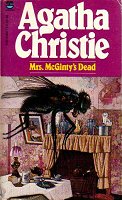- first published 1952
- this edition a Fontana papeback printed in 1952
- 188 pages
- source: my own book shelves
- an Hercule Poirot with some assistance from Ariadne Oliver
Mrs McGinty dies from a brutal blow to the back of her head. Suspicion immediately falls on her shifty lodger, James Bentley, whose clothes reveal traces of the victim's blood and hair. Yet something is amiss: Bentley just doesn't look like a murderer. Poirot believes he can save the man from the gallows - what he doesn't realise is that his own life is now in great danger...
First published in 1952, the novel was adapted by MGM in 1964, and released as 'Murder Most Foul'. The character of Hercule Poirot was replaced by Jane Marple, played by Margaret Rutherford. In 2008 David Suchet starred as Poirt and Zoë Wanamaker as Ariadne Oliver in the ITV production.
My take
Now retired, Hercule Poirot does not have enough to keep him busy. The only important events in his life are his three meals a day, and so when Superintendent Bert Spence, who he met on an earlier case, comes to see him about the McGinty case he welcomes some activity. James Bentley has just been found guilty of Mrs McGinty's murder but has not yet been sentenced. Superintendent Spence is not happy that Bentley is really guilty and asks Poirot to retrace the investigation.
The problem with Bentley is that he is such a hangdog that he looks guilty and Poirot thinks that he can't blame the jury for their verdict, but he doubts that Bentley could kill anyone. Poirot goes to stay in the village of Broadhinny and puts it about that there is new evidence come to light that Bentley may not have committed murder after all. As Poirot questions those Superintendent Spence has already questioned, new evidence does indeed come to light. Someone tries to push Poirot under a train so he knows he is on the right track, but he is not quick enough to prevent another murder. Ariadne Oliver is chagrined to learn it has taken place under her very nose.
This is a carefully woven plot with Poirot trying to track down the identity of four women whose photos appeared in the local paper. There are several likely people and we see an idea surfacing that was used in an earlier novel, that so many people lost their identity papers during air raids and dislocation during the Second World War, that you can never be sure that people are who they say they are.
Poirot again gets a young woman to assist him in his investigation, and in the final pages we glimpse him indulging in some matchmaking.
A good read, but I really can't go along with Miss Marple replacing Hercule Poirot (see Synopsis).
My rating 4.4
See what others who are contributing to this week's edition of Pattinase's Friday's Forgotten Books are up to this week.

Kerrie - Oh, I quite agree! The original Mrs. McGinty's Dead depends in part on Poirot's reaction to the village of Broadhinny and especially to Long Meadows, where he's staying while he solves the case. His personality matters in that novel. And I really do like this novel, not least because it was the first Agatha Christie I read - sentimental value I suppose.
ReplyDeleteNice review Kerrie - this is one of my favourite AC books.
ReplyDelete